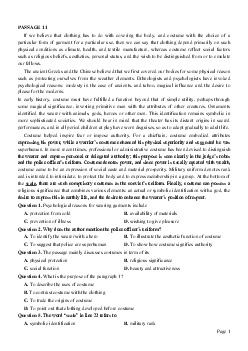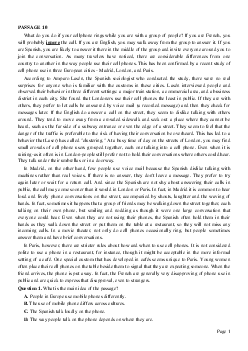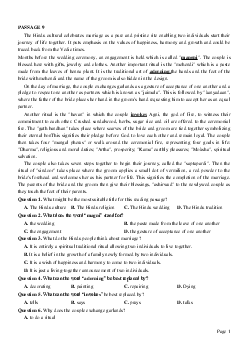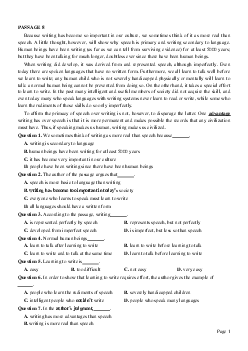

Preview text:
PASSAGE 9
Human Nutrition is the study of how food affects the health and survival of the human body. Human
beings require food to grow, reproduce, and maintain good health. Without food, our bodies could not
stay warm, build or repair tissue, or maintain the heartbeat. Eating the right foods can help us avoid
certain diseases or recover faster when illness occurs. These and other important functions are fueled by
chemical substances in our food called nutrients. Nutrients are classified as carbohydrates, proteins, fats,
vitamins, minerals, and water.
When we eat a meal, nutrients are released from food through digestion. Digestion begins in the mouth
by the action of chewing and the chemical activity of saliva, a watery fluid that contains enzymes, certain
proteins that help break down food. Further digestion occurs as food travels through the stomach and the
small intestine, where digestive enzymes and acids liquefy food and muscle contractions push it along the
digestive tract. Nutrients are absorbed from the inside of the small intestine into the bloodstream and
carried to the sites in the body where they are needed. At these sites, several chemical reactions occur,
which ensures the growth and function of body tissues. The parts of foods that are not absorbed continue
to move down the intestinal tract and are eliminated from the body as feces.
Once digested, carbohydrates, proteins, and fats provide the body with the energy it needs to maintain its
many functions. Scientists measure this energy in kilocalories, the amount of energy needed to raise one
kilogram of water one degree Celsius. In nutrition discussions, scientists use the term calorie instead of
kilocalorie as the standard unit of measure in nutrition.
Nutrients are classified as essential or nonessential. Nonessential nutrients are manufactured in the body
and do not need to be obtained from food. Examples include cholesterol, a fatlike substance present in all
animal cells. Essential nutrients must be obtained from food sources, because the body either does not
produce them or produces them in amounts too small to maintain growth and health. Essential nutrients
include water, carbohydrates, proteins, fats, vitamins, and minerals.
An individual needs varying amounts of each essential nutrient, depending upon such factors as gender
and age. Specific health conditions, such as pregnancy, breast-feeding, illness, or drug use, make unusual
demands on the body and increase its need for nutrients. Dietary guidelines, which take many of these
factors into account, provide general guidance in meeting daily nutritional needs.
From “Human Nutrition” by Worthington-Roberts, Bonnie, Microsoft ® Student 2009.
Question 1. The first paragraph mainly discusses .
A. chemical substances in our food
B. a variety of essential nutrients to human beings
C. the importance of food to human beings
D. the study of human nutrition
Question 2. The word “released” in the second paragraph mostly means “” A. refused B. produced C. expressed D. renewed
Question 3. Which of the following is NOT true about the process of digestion
A. The small intestine covers the whole digestive system.
B. The small intestine helps the body absorb nutrients.
C. Nutrients are carried to different sites in the body
D. Saliva plays an important role in the first stage of digestion
Question 4. The word “maintain” in the paragraph is closest meaning to “” A. obtain B. provide C. keep performing D. carry on making Page 1
Question 5. According to the passage, nutrients are absorbed . A. over the whole body B. in the mouth C. in the stomach
D. in the small intestine
Question 6. According to the passage, which of the following provides energy for the body?
A. Proteins, fats, and minerals
B. Carbohydrates, proteins, and fats
C. Carbohydrates, minerals, and water
D. Proteins, vitamins, and carbohydrates
Question 7. In nutrition discussions, the standard unit used to measure nutrients is . A. kilocalorie B. kilogram C. calorie D. gram
Question 8. The word “which” in the last paragraph refers to . A. general guidance B. unusual demands C. dietary guidelines D. nutritional needs
Question 9. Which of the following is NOT mentioned in the passage?
A. Classification of nutrients
B. The body’s need of nutrients
C. The effects of food on the body
D. Food sources from animals
Question 10. Through the passage, the author provides the readers with . A. instructions B. some information C. some proposal D. orders ĐÁP ÁN 1-B 2-B 3-A 4-C 5-D 6-B 7-C 8-C 9-D 10-B Page 2




